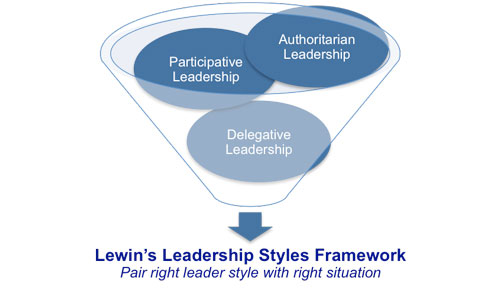Lewin's Leadership Styles Framework
It is pretty evident that there are plenty of different ways in which a leader can manage his or her employees or team members. No matter the setting, there are a variety of options available to the leader depending on what strategy they believe will pull the best possible performance out of their team. Not only can leadership strategies vary from person to person, but the same person can often use different strategies in different situations in order to achieve maximum results. The leader who is stuck in only one way of thinking and never responds to the changes going on around them is one who is unlikely to be a leader for long.
The Lewin's Leadership Styles Framework dates back many years - to the 1930's, in fact - but it is still relevant today because it divides leadership styles up into three easy to remember groups. While these groups might not necessarily capture all of the subtlety that is contained within a given leader or manager, they do a good job of highlighting the overall approach.
 |
Based on the situation, any of these three styles could be the perfect one for the job. At the same time, any of these three could be the wrong one for the job if used under incorrect circumstances. Pairing the right leadership style with the right situation is a task that every leader should take quite seriously.
Let's take a closer look at each of the three leadership styles that Kurt Lewin presented in his framework.
Authoritarian Leadership
This leader is one who takes command and doesn't care to pass on any of the decision making responsibility to members of his or her team. An authoritarian leader is makes decisions independently and is convinced that they are the correct decision for the circumstances regardless of the feelings of any members of the team. Typically, there would be very little interaction between the leader and team members under this type of leadership style. The leader will pass down assignments and objectives to the team, with specific instructions on how to get the job done.
There are both positives and negatives associated with this style of leadership. On the positive side, it can be an effective strategy when dealing with an inexperienced team who lacks the knowledge to take a more autonomous role in the project. When a team is made up of individuals who need specific instructions to succeed, the authoritarian leader could be the perfect choice for the job. At the same time, an experienced team might push back against this type of leadership because it doesn't offer them the freedom and creativity that they feel they have earned. It is important that the leader evaluate carefully the members of the team before deciding how to best lead them through any task.
Participative Leadership
As the name would indicate, this type of a leader is going to get in as part of the team and get to work. While they remain in charge and hold decision making power, the process is far more collaborative and cooperative. Team members are encouraged to give their ideas and their feedback, for the good of the group as a whole. The leader will consider ideas put forward by the team and may take them up if it is deemed to be in the best interest of the project. Generally speaking, this kind of leader is better-liked by the members of the team because they are seen as one of the group - as opposed to acting as a dictator who simply passes down orders.
Of course, this type of leadership will not work with every team. Thinking about the inexperienced team from the previous example, participative leadership might not be the right way to get them through a project. Without strong leadership, their lack of experience could become a major problem. However, a team with moderate experience and plenty of enthusiasm could be just right for this option. As long as there is enough knowledge in the group to keep the project moving in the right direction, the participation of the leader should only further the productivity achieved. Also, the members of the team may stay better engaged and motivated because they feel invested as part of the process.
Delegative Leadership
The last of the three groups is the most 'hands off' from the leader's perspective. A leader who delegates the majority a project is one that has complete trust in his or her team and will allow them to run with the job. Other than monitoring the progress of a given project, and checking in the status of the work from time to time, this leader will likely leave the team members alone to do what they do best. Not surprisingly, this is typically the preferred style of the leadership from the team member's perspective - having a leader who is available when needed, but not getting in the way or micromanaging the work.
It should go without saying that using this management style with a team who isn't prepared to handle it properly is a recipe for disaster. An inexperienced team, or one that isn't properly motivated and focused on the task at hand, could use the freedom provided by leadership delegation to get off-task and fall behind on project deadlines. If a leader is going to trust his or her reputation to the performance of the team, they need to be highly confident in each member of that group.
As you can see, the three styles of leadership put forward by Lewin's Leadership Styles Framework each can be successful when put to use in the right time and place. Trying to use the wrong style with the wrong group of people, however, could lead to big trouble for both the members of the team and the leader. As the group evolves and changes over time, so to should the management style that is being used adapt to the needs of the team as a whole. When the leadership style closely matches the profile of the team in question, great results can occur.
You may also be interested in:
Action Centered Leadership | Blake-Mouton Managerial Grid | Dunham and Pierce's Leadership Process Model | Fiedler's Contingency Model | French and Raven's Five Forms of Power | Hersey-Blanchard Situational Leadership Theory | Tannenbaum-Schmidt Leadership Continuum | Lewin's Leadership Styles Framework | Path-Goal Theory | Zenger and Folkman's 10 Fatal Leadership Flaws.



